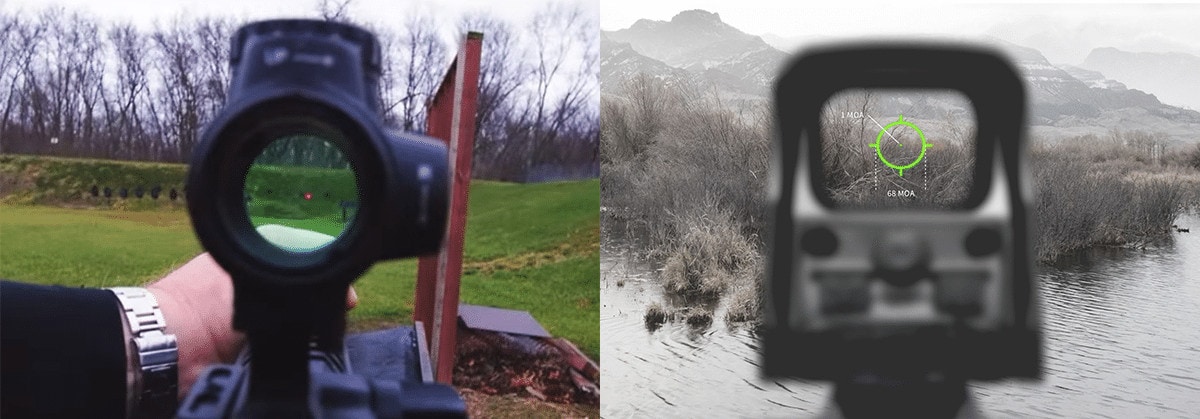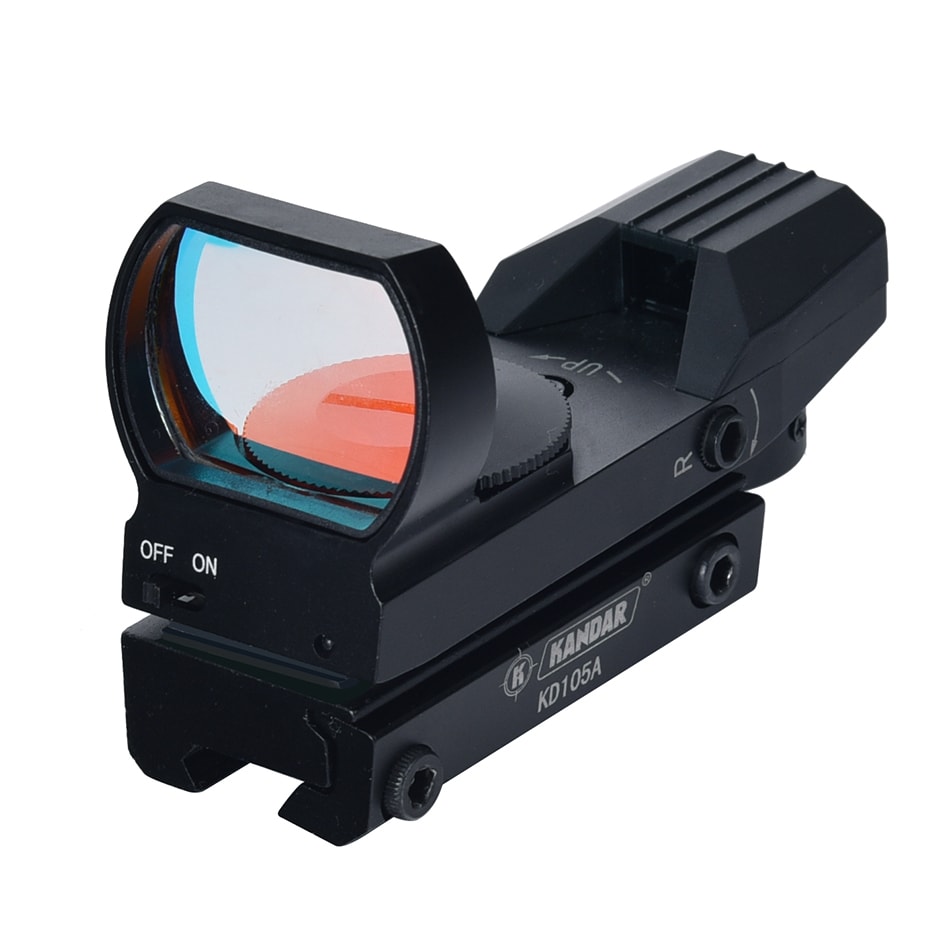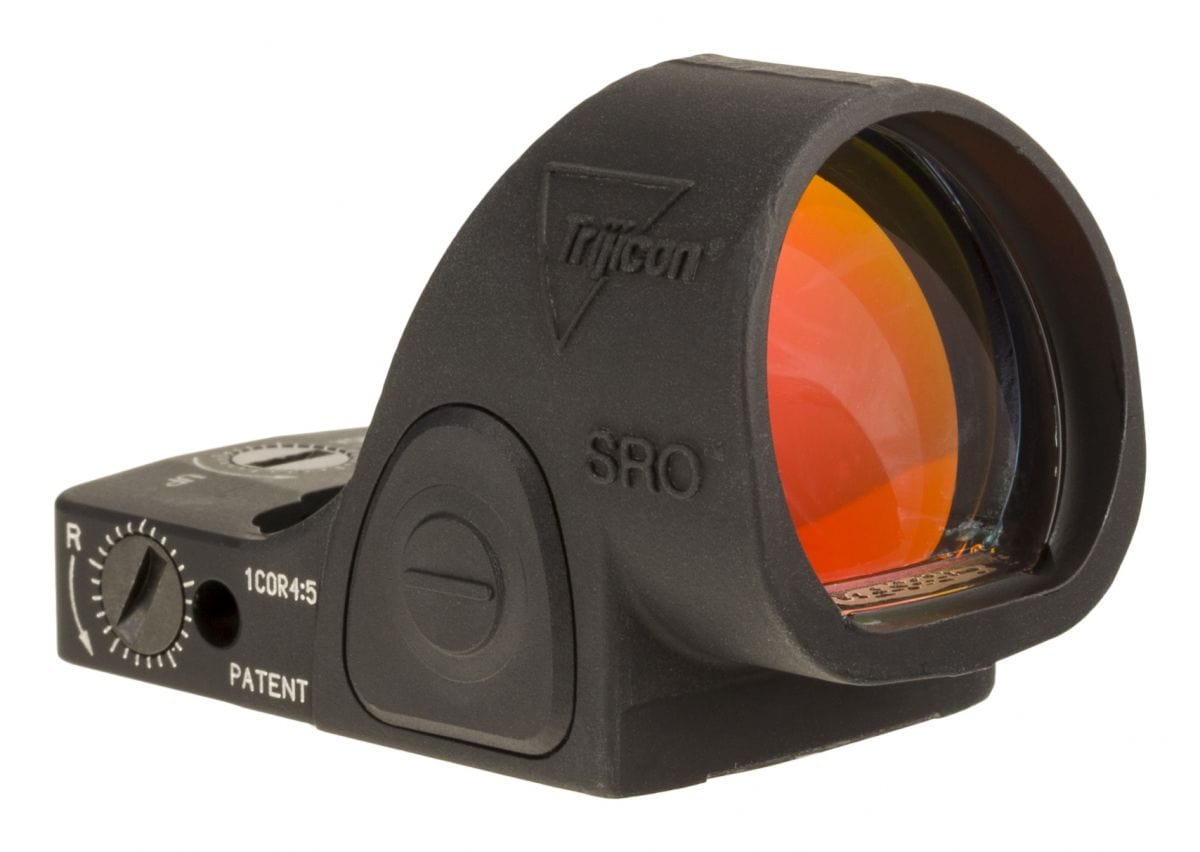Red dot optics are built on a concept devised by an Irish optical inventor in the year 1900 and picked up for resolving iron sight problems on rifles.
By the year 1918 with the great war raging, such sights had already been mounted on fighter planes. The next big advancement came in the 1970s when red dots began being used on handheld weapons. And the latest milestone was hit in the ’90s with the development of holographic sights.
Red dots are often misunderstood due to the fine line of difference between their variants. Which is what this article intends to address, and surely will if you keep your eyes pinned!

Photo credit: gunpros.com
TL;DR: Holographic vs Red Dot Sights
Red Dot Sights | Holographic Sights |
|---|---|
Pros | Pros |
|
|
Cons | Cons |
|
|
Best For | Best For |
Great for home defense, competitions, close range hunting, and combat. | Holographic sights are a battle-proven optic and are widely used by the military. Best for all the same situations where you can afford it |
What is a Red Dot?
A red dot sight is a non-magnifying optical sighting system mounted on top of a firearm. The sight gets its name from an illuminated colored dot that sits on the center of the glass and acts as an aiming point. So basically, any optical sight with such a dot can be called a red dot sight.
Red dot sights use an LED and collimating mirror assembly to reflect the image of the dot and project it towards the user. Some red dot sights use a prism setup instead of lenses and are known as prism sights. Such sights can sometimes be useful in overcoming problems that arise due to medical eyesight conditions like astigmatism.
Since red dot sights use a collimator mirror assembly, these sights are almost ‘parallax free’. If you don’t know what that is, check out this article on parallax.
Red dot sights can have a closed or open lens setup. The closed variants look like regular rifle scopes but smaller in length. Whereas open variants look like simple lens housing standing against a flat base.
There are smaller red dot sights, also known as miniature red dots. These are used with pistol carbines, handguns, and revolvers.
What is a Holographic?
The term holographic has been derived from a hologram. Which refers to a two or three-dimensional image of an object. This concept has been implemented on gun optic sights and resulted in what’s known as Holographic sights or holo sights.

Photo credit: sportsmansguide.com
The design was invented in 1996 and introduced by EOTech. A company that has been supplying high-quality optics to the U.S Military for quite some time now. EOTech was the sole manufacturer of holographic sights (and it still is to a significant level) unless Vortex introduced its first and only AMG UH-1 holo sight in 2017.
Holographic sights are complex optics that feature a sophisticated collimator lens and laser diode setup that helps create a superimposed image of the target. Holo sights are also almost parallax-free and stay on target regardless of your head movement. More on their benefits later.
Holographic sights can come in some complex reticles which are available in red and green colors. Essentially, a holographic sight is a kind of red dot sight.
Relevant Characteristics Between Red Dot and Holographic
Spec | Red Dot Sights | Holographic Sights |
|---|---|---|
Size | 1.5 - 6 inches (length) | 3.8 - 5.6 inches (length) |
Weight | 1 - 8 ounces | 9 - 11 ounces |
Durability | Low - high | High |
Battery | 10,000 - 50,000 hours | 300 - 1200 hours |
Magnification | 1x (magnifiable) | 1x (magnifiable) |
Similarities and Differences
Red dots and holographic sights are widely in use across military and civilian arenas. Both these sights have a few similarities and differences that can prove to be the deciding factor for your purchase. So it’s better to be aware of them.
Red Dot and Holographic Differences
Complexity
Holographic sights are technically more complex in design compared to the simpler red dot sights. This complexity creates a significant difference in some factors for these sights from performance to price. Holo sights are a newer refinement of the red dot concept and have been successfully used by the military.
Battery Life
Red dot sights are the clear winner when it comes to battery life. Due to their lesser complex design, red dots can deliver a battery life of up to 50,000 hours at medium or low illumination settings. That’s a reason why many users don’t even bother to switch them off.
Holo sights, on the other hand, can deliver a maximum battery life of 1,200 hours. A feat that has been achieved in the latest EOTech models a couple of years ago.
Size & Weight
Holo sights have a lot of stuff to pack inside. That’s what makes them technically superior and more advanced compared to red dots. With that said, holo sights will always be bulkier than the biggest red dot sights or scopes.
EOTech tried to resolve this issue with their smaller XPS series of holo sights. Which is a great improvement. But if a lighter optics wins over functionality for you. Red dot sights are your pick.

Photo credit: youtube.com
Price
Now let’s talk about the factor that’ll decide 60% of buying decisions. The economics. The price of holographic sights starts from where the most costly red dots end. Call it a result of market monopoly, reputation fads, or superior technology. An HWS (Holographic Weapon Sight) will burn a bigger hole through your wallet.
Red Dot and Holographic Similarities
Basic Principle and Reticles
The basic principle of red dot sights has been around for more than a century now. But the illumination concept was added in the late ’70s. Now it may seem a bit contradictory since we’re talking about the differences. But the holo sight is an advanced version of red dots.
Both these sights often feature similar reticles and available options for them.
Power Source
Since these sights employ the use of electricals, it is imperative to have a power source. This also means that these sights become useless once the battery dries out. However, there’s a slight difference in this too. Red dot sights require lesser power and hence run on button cells. Whereas holo sights draw more power and are used with larger batteries.
Magnification & Night Vision
Holo and red dot sights offer 1x magnification of the target. Now that means the target will appear where it is. However, you can club either of these sights with a magnifier to increase the effective viewing range.
Additionally, both these sights offer variants that allow compatibility with night vision devices. Hence making the sight more suitable for tactical applications.

Photo credit: pinterest.com
Fast Acquisition
A very useful feature of red dot sights is their quick target acquisition capability. While holos are an inch ahead in that matter compared to red dots. But both these sights are great for quickly picking up your target and squeezing the trigger.
The main reason for that is the unlimited eye relief and almost parallax-free design. Which allows the user to shoot with both eyes open.
Similar Mounting System
Being very compact in design compared to the large rifle scopes. These sights attach to a Picatinny or Weaver rail system. They can be positioned and can also be used in conjunction with other optics or iron sights.
Advantages of Red Dot Sights
But why should you go for a red dot sight? To decide on that, you will need to look at some advantages of red dot sights.
Easy Target Acquisition
Grabbing hold of a target within your optic sights is lightning fast with red dot sights. The illuminated dot is a great feature for low light use and also for people with weak eyesight. Red dot generally offers a bigger size dot that is excellent for close-quarter engagements. Where precision for point of impact is not the most important concern.

Photo credit: alibaba.com
Long Battery Life
A highly differentiating factor that makes red dot sights admirable is their long battery life. All that needs power inside the sight setup is a small LED light. Often powered by a button cell, red dot sights can offer you a runtime of about 50,000 hours. That’s about five years if you keep the sight constantly switched on.
This is a great feature for people who forget to switch off their optics. Or people who fret over replacing the batteries now and then.
Affordable, Compact & Lightweight
Red dot sights come in a variety of sizes. From tubed close sights to mini sights for handguns. You will find a wide range of options to choose from. These sights do not pack a lot of electrical stuff inside their housing. Which means they can be lighter in weight. Plus, the compact size allows them to be used with other options as well.
You’ll not end up adding a significant amount of weight over your rifle with a red dot sight. Apart from all this, red dots come in a wide range of price options. Starting from $35 and all the way up to $500.
Advantages of Holographic Sights
Switching over to holographic sights now. These optics are not inexpensive and may cost twice or thrice more than most mid-range red dots. But despite the price tag, they have their differentiating advantages.
Better Target Acquisition
Pay attention to the fact that holo sights offer ‘better’ target acquisition. Not just easy, not only quick but better in every aspect. That’s because these sights allow you to focus on the reticle and the target at the same time. Thanks to holographic technology, the reticle always stays in focus. The major benefit being lesser parallax distortion and a better field of view compared to red dot sights. That’s a big reason why combat operatives prefer these sights.

Photo credit: amazon.com
Works When Broken
This will sound interesting and also something worth spending 500 bucks for. Holographic sights continue on working even if the front lens is partially broken or smeared in any contaminant. That’s a feature unique to holographic sights. Again, thanks to holographic technology.
Reticle Size with Magnification
Holographic sights offer reticles with finer dots and other advanced designs that help you quickly acquire targets and shoot accurately. Even under stress. One great feature of holo sights that red dot optics lack is the dot size under magnification.
Suppose your holographic sight has a 1 MOA red dot and you plan to use a 3x magnifier to extend your range. This 1 MOA dot will still be a 1 MOA dot even when seen through a magnifier. Unlike red dot sights where the dot size also magnifies.
The advantage of this feature is that you will get pinpoint accuracy like a rifle scope even when increasing your shooting distance.
What About Reflex Sights?
Reflex sights are a classification of red dot sights. The idea of reflector sights originated in the year 1900 in the mind of Irish optical designer Howard Grubb. It was first used on German fighter aircraft in 1918 and by WW2, these sights were very popular in fighter airplanes and heavy guns.
Speaking in general and colloquially correct aspects, a reflex sight is a red dot sight that can be open or closed (tubular) in design. The dot of a reflex sight remains on the target, even if the head of the shooter moves sideways.
Photo credit: bhphotovideo.com
Reflex sights have been around since the second world war whereas red dot sights came into being in the late 1970s.
Reflex sights are inexpensive and can come in a variety of reticle options. Their battery life expectancy is similar to that of red dots but you cannot expect them to be used for more complex applications. The durability is also not suitable for combat levels. But then, designs differ.
When and Why Would I Use a Red Dot?
By now, you must’ve understood that a red dot is a generalized term. But for the sake of discussion, we will talk about reflex and prism sights in this section.
Red dots were designed for quick target acquisition and helping the shooter to aim with both eyes open. The lens aperture helps improve your focus and congests your broad field of view inside a small circle or rectangle. With a simple aiming point that can be adjusted for brightness.
Red dots eliminate the need for too much alignment. Which is a problem with iron sights. Hence, a red dot scope will be a great tool in combat or defensive situations where hitting the target quickly is essential.
Sights that come with small dots can also be used for competitions where you have to bust many targets in quick succession.
Red dots are mostly inexpensive and the long battery life ensures that you can rely upon them when you have to reach for a firearm in a dark home defense situation.
These sights are also good on shotguns and can be used for duck or turkey hunting.

Photo credit: optics-world.nl
When and Why Would I Use a Holographic Sight?
Frankly speaking, holographic sights are military tech and are mostly used by the military. They are only found on the market because people like to depend upon the battle-proven military stuff.
People who are most likely to buy holo sights will be active-duty officers, preppers, competitive shooters, and tactical operators. Essentially those who are willing to spend extra money on a small red dot and also don’t mind changing batteries very often.
Holographic sights are a battle-proven optic. EOTech is the single largest manufacturer and supplier of these sights to the U.S Military. Despite the lawsuit filed against them by USSOCOM in 2016 for misinformation on ‘thermal drift’ problems. EOTech again won the contract to supply special forces holo sights and is still trusted by military operatives.
Holographic sights are great for combat. Especially when you are shooting at moving targets and want your target and the reticle to always be in focus. These sights are very tough and can work in partially broken conditions. Plus, the magnification doesn’t affect dot size. Which helps with longer range accuracy as well.
So overall, holo sights have been designed for battle and will be used best there.
Bottom Line
Red dot sights is a generalized term for firearm optics that use an illuminated red dot as a reticle. The design of this reticle can vary a bit among different variants of a red dot sight, but the basic concept remains the same.
Holographic sights are an advanced type of red dot sight that delivers a 2D or 3D image of the target. Hence helping the user gain more focus and a better field of view on the target. Holographic sights are a tad bulky and have lower battery life. But are superior to other red dot sights in terms of features and performance.

Photo credit: sigsauer.com
People Also Ask
Check out this brief and informative FAQ section that’ll help you resolve some minor queries about red dot sights.
How Accurate Are Red Dots?
When used within the effective range, red dots are very accurate. So mostly it’s a close range under 100 yards. If you are using a magnifier, holographic sights will be more accurate than reflex or prism sights.
What Distance Should You Zero a Red Dot Sight?
It depends upon your shooting distance and the kind of weapon. Since red dots are mostly used in the short range, most people prefer a 50 yard zero. Whereas those using magnifiers can aim for 100 yards.


